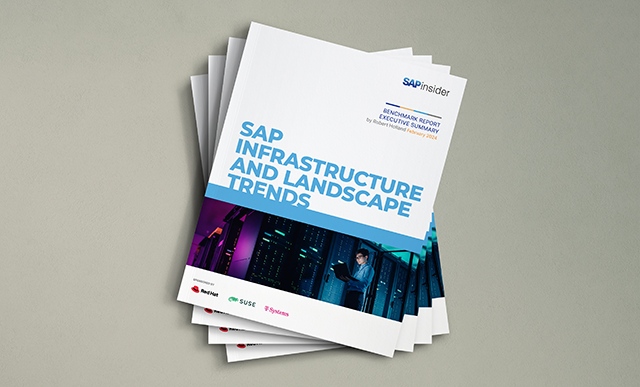By Robert Holland, VP Research and Publishing, SAPinsider
The report was based on responses to a survey taken by SAP customers working in a variety of industry sectors. This article looks specifically at survey respondents in the retail and distribution sector (respondents who chose Apparel & Footwear, Consumer Goods, Service, and Retail industries), and how those respondents differ from respondents in other market sectors in terms of where their ERP systems are running, what drivers are most likely to be impacting their ERP cloud strategy, and how this impacts their overall system performance.
Retail & Distribution Organizations Have More On-Premise Implementations
One of the most notable findings from the survey is that retail & distribution companies were 47% more likely to be running their existing ERP system in a fully on-premise environment than respondents in other market sectors. There was also a marked difference in the percentage of retail and distribution organizations using hybrid environments without hyperscalers (5%) when compared to other sectors (21%).

Retail & distribution organizations were also less likely to have cloud-based deployments of their ERP systems in all areas, save for hybrid environments that leveraged hyperscalers (see
Figure 1).
Among respondents whose organizations remained on-premise, 33% of those who provided further details said they were still running on-premise for historic or legacy reasons, and 22% said they had not reached the end of their existing hardware lifecycle. Despite these responses about their existing systems, 82% were either evaluating, piloting, or already deploying SAP S/4HANA, so these organizations are pursuing new implementation options.
Additional reasons for why respondents’ organizations are currently deploying on-premise includes concerns about security in the cloud (17%), compliance reasons (6%), and concerns about the cost of moving to a cloud environment (6%). These results reflect data that we have seen in SAPinsider’s “Enterprise Cloud Migration: State of the Market” report which indicated that the top criteria for selecting a cloud vendor were price and security.
Retail and Distribution Organizations Are Looking to Centralize Their ERP System
When examining the factors detailed in the report that are driving an organization’s ERP cloud strategy, the largest impact for leaders (those who reported excellent or exceptional performance from their ERP systems) was the demand for faster deployment of SAP instances. This was also true for retail and distribution organizations who reported that the demand for faster deployment was one of the top two drivers at a slightly higher rate than respondents from other sectors (31% vs. 22%). The most significant difference was in the number of respondents in the retail and distribution sector who indicated that the desire to centralize and harmonize ERP was one of the top two drivers impacting their ERP cloud strategy. With nearly twice the frequency as other market sectors (41% vs. 22%), this was the number one driver for those in retail and distribution organizations as shown in
Figure 2. Compared to all respondents, the top two drivers were pressure to lower overall IT spend, and the need to mitigate the risk of SAP S/4HANA deployment.
This focus on centralizing and harmonizing their ERP systems is a major factor in the retail and distribution sector because it provides for
centralized data that will allow an accurate picture of business-critical information like global inventory, something that’s critical for supporting online ordering. Similarly, having a central master data repository means that customer and vendor records can have a single version of the truth. It also ensures for a cleaner data set that can support new cloud-based technologies like Machine Learning and Artificial Intelligence to provide the potential for competitive advantage.
Looking at the requirements that are supporting these drivers, the top two capabilities for all respondents were certified and guaranteed security and the uninterrupted availability of SAP systems. Standing out for respondents in the retail and

distribution sector was the need for real-time processing (see
Figure 3). This connects directly to their need to centralize and harmonize ERP data, as it will allow them to utilize that centralized data to immediately gain more insight into their businesses and leverage the embedded analytical capabilities that their ERP systems provide.
In examining the technologies that are needed to support these capabilities, the
only areas in which retail and distribution organizations were ahead of other sectors were virtualization or a hyper-converged infrastructure, and SAP Fiori-based apps, by a 2% and 1% margin respectively. This can be explained by the fact that all of the technologies we asked about were focused on a cloud-based strategy, and organizations in
the retail and distribution sector are further behind on their cloud adoption as discussed previously.
However, as they perform the centralization of their ERP systems, their technology investments will exceed those of other sectors over the next 12-24 months in the areas of dedicated internet connections (41% vs. 36%), cloud management tools (49% vs. 42%), cloud-native apps (46% vs. 38%), and cloud integration solutions (51% vs. 43%). This shows that although they are currently behind in their approach to the cloud, the retail and distribution sector will be adopting it at an accelerating pace as they take disparate ERP deployments and data marts and centralize and make them accessible to their global
user base.
 What Does This Mean for SAPinsiders?
What Does This Mean for SAPinsiders?
Based on
our research, the following considerations can help SAP organizations in the retail and distribution discretionary sector understand what they do well and what they can learn from ERP performance leaders:
- Seek deployment strategies that include the cloud. Even though most organizations in the retail and distribution sector have their existing ERP system deployed on-premise, those that are working in a cloud or hybrid environment are seeing exceptional ERP system performance – and only 3% of respondents in retail and distribution organizations that are seeing average or poor performance in their ERP systems have deployments in the cloud.
- Use the cloud to deliver deployment agility and real-time processing capabilities. With the ability to quickly configure space in a hybrid or cloud-based landscape at a low cost, setting up an environment for a small or large deployment can be easily achieved. This will provide the ability to address a short- or long-term need quickly, and the elastic capabilities of the cloud will deliver the required performance.
Start by deploying in a hybrid model. Finding a path to leverage performance benefits does not need to involve a full deployment in the cloud. Most respondents in the retail and distribution sector who had a hybrid deployment model with a hyperscale.
 Retail & distribution organizations were also less likely to have cloud-based deployments of their ERP systems in all areas, save for hybrid environments that leveraged hyperscalers (see Figure 1).
Among respondents whose organizations remained on-premise, 33% of those who provided further details said they were still running on-premise for historic or legacy reasons, and 22% said they had not reached the end of their existing hardware lifecycle. Despite these responses about their existing systems, 82% were either evaluating, piloting, or already deploying SAP S/4HANA, so these organizations are pursuing new implementation options.
Additional reasons for why respondents’ organizations are currently deploying on-premise includes concerns about security in the cloud (17%), compliance reasons (6%), and concerns about the cost of moving to a cloud environment (6%). These results reflect data that we have seen in SAPinsider’s “Enterprise Cloud Migration: State of the Market” report which indicated that the top criteria for selecting a cloud vendor were price and security.
Retail & distribution organizations were also less likely to have cloud-based deployments of their ERP systems in all areas, save for hybrid environments that leveraged hyperscalers (see Figure 1).
Among respondents whose organizations remained on-premise, 33% of those who provided further details said they were still running on-premise for historic or legacy reasons, and 22% said they had not reached the end of their existing hardware lifecycle. Despite these responses about their existing systems, 82% were either evaluating, piloting, or already deploying SAP S/4HANA, so these organizations are pursuing new implementation options.
Additional reasons for why respondents’ organizations are currently deploying on-premise includes concerns about security in the cloud (17%), compliance reasons (6%), and concerns about the cost of moving to a cloud environment (6%). These results reflect data that we have seen in SAPinsider’s “Enterprise Cloud Migration: State of the Market” report which indicated that the top criteria for selecting a cloud vendor were price and security.
 distribution sector was the need for real-time processing (see Figure 3). This connects directly to their need to centralize and harmonize ERP data, as it will allow them to utilize that centralized data to immediately gain more insight into their businesses and leverage the embedded analytical capabilities that their ERP systems provide.
In examining the technologies that are needed to support these capabilities, the
only areas in which retail and distribution organizations were ahead of other sectors were virtualization or a hyper-converged infrastructure, and SAP Fiori-based apps, by a 2% and 1% margin respectively. This can be explained by the fact that all of the technologies we asked about were focused on a cloud-based strategy, and organizations in
the retail and distribution sector are further behind on their cloud adoption as discussed previously.
However, as they perform the centralization of their ERP systems, their technology investments will exceed those of other sectors over the next 12-24 months in the areas of dedicated internet connections (41% vs. 36%), cloud management tools (49% vs. 42%), cloud-native apps (46% vs. 38%), and cloud integration solutions (51% vs. 43%). This shows that although they are currently behind in their approach to the cloud, the retail and distribution sector will be adopting it at an accelerating pace as they take disparate ERP deployments and data marts and centralize and make them accessible to their global
user base.
distribution sector was the need for real-time processing (see Figure 3). This connects directly to their need to centralize and harmonize ERP data, as it will allow them to utilize that centralized data to immediately gain more insight into their businesses and leverage the embedded analytical capabilities that their ERP systems provide.
In examining the technologies that are needed to support these capabilities, the
only areas in which retail and distribution organizations were ahead of other sectors were virtualization or a hyper-converged infrastructure, and SAP Fiori-based apps, by a 2% and 1% margin respectively. This can be explained by the fact that all of the technologies we asked about were focused on a cloud-based strategy, and organizations in
the retail and distribution sector are further behind on their cloud adoption as discussed previously.
However, as they perform the centralization of their ERP systems, their technology investments will exceed those of other sectors over the next 12-24 months in the areas of dedicated internet connections (41% vs. 36%), cloud management tools (49% vs. 42%), cloud-native apps (46% vs. 38%), and cloud integration solutions (51% vs. 43%). This shows that although they are currently behind in their approach to the cloud, the retail and distribution sector will be adopting it at an accelerating pace as they take disparate ERP deployments and data marts and centralize and make them accessible to their global
user base.
 What Does This Mean for SAPinsiders?
Based on
What Does This Mean for SAPinsiders?
Based on 



